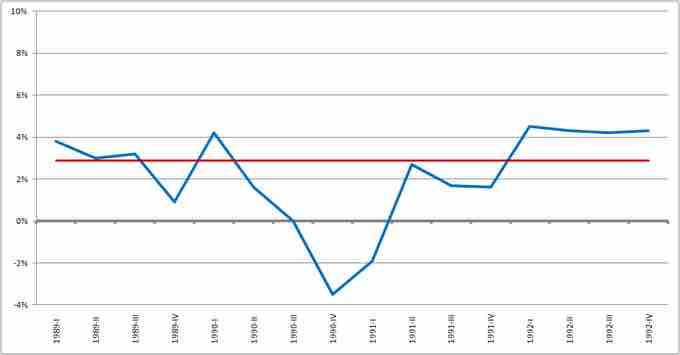The Recession of the Early 90s
Coming at around the same time as President Bush's budget deal with Congress, the United States entered into a mild recession that lasted for six months. As the unemployment rate edged upward in 1991, Bush signed a bill providing additional benefits for unemployed workers. By 1992, interest and inflation rates were the lowest in years, but by midyear the unemployment rate reached 7.8%, the highest since 1984. In September 1992, the Census Bureau reported that 14.2% of all Americans lived in poverty.
Background
On Black Monday of October 1987, a stock collapse of unprecedented size caused the Dow Jones Industrial Average to fall by 22.6%. This collapse, larger than that of 1929, was handled well by the economy, and the stock market began to quickly recover. However, in North America, the lumbering savings and loans industry was beginning to collapse, leading to a savings and loan crisis which put the financial well-being of millions of Americans in jeopardy.
The panic that followed led to a sharp recession through financial contagion, which hit hardest those countries most closely linked to the United States, including Canada, Australia, and the United Kingdom. The economies of much of Europe and Japan were also hurt but not as badly. The U.S. economy continued to grow as a whole, although certain sectors of the market such as energy and real estate slumped.
The first burst of the recession was short-lived, as fervent pre-election activity by the governments of the United States and Canada created what many economists at the time saw as an economic miracle: a growing consumer confidence and increased consumer spending almost single-handedly lifted the North American economy out of recession.
The Gulf War and Oil
It soon turned out that the quick recovery was illusory, and by 1990, economic malaise had returned with the beginning of the Gulf War and the resulting 1990 spike in the price of oil, which increased inflation (albeit to less of a degree than did the oil crisis of ten years earlier). Nevertheless, for the next several years, high unemployment, massive government budgetary deficits, and slow Gross Domestic Product (GDP) growth affected the United States until late 1992 and Canada until 1995. The rest of the world was less affected by the downturn; Germany and Japan both grew rapidly. Some pundits guessed – wrongly, as it turned out – that this would be a permanent state of affairs and that both the German and Japanese economies would grow to be larger than America's.
Political Ramifications
While the election campaign of George H. W. Bush in the United States may have been aided by the brief recovery of 1988, he could not hold on to power through the last part of the recession. Bush's 1992 re-election bid was particularly hampered by his 1990 decision to renege on his "no new taxes" pledge during his first campaign in 1988.

Recession in the U.S., early 1990s
This graph illustrates the GDP growth (at annualized rates) in the United States between 1989 and 1992, showing the 1990-91 recession.